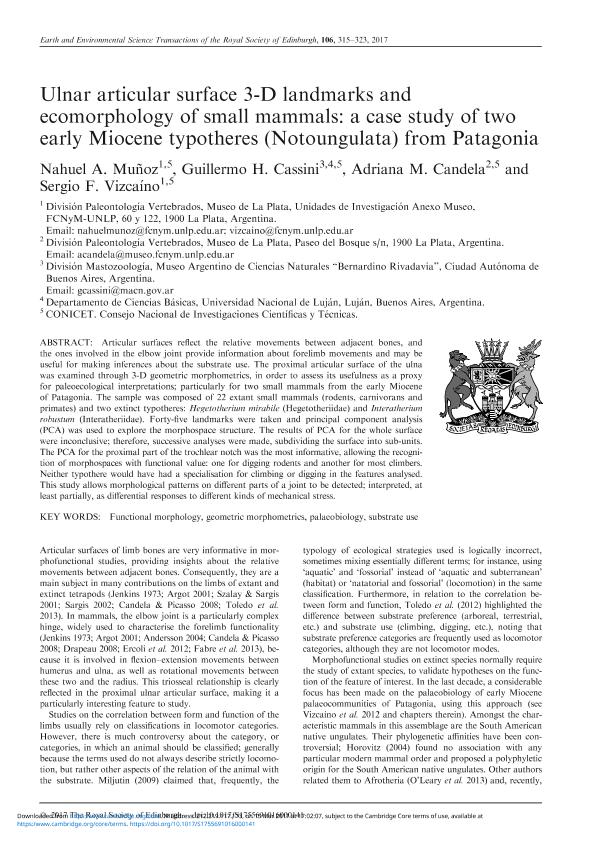Artículo
Ulnar articular surface 3-D landmarks and ecomorphology of small mammals: A case study of two early Miocene typotheres (Notoungulata) from Patagonia
Muñoz, Nahuel Antu ; Cassini, Guillermo Hernán
; Cassini, Guillermo Hernán ; Candela, Adriana Magdalena
; Candela, Adriana Magdalena ; Vizcaíno, Sergio Fabián
; Vizcaíno, Sergio Fabián
 ; Cassini, Guillermo Hernán
; Cassini, Guillermo Hernán ; Candela, Adriana Magdalena
; Candela, Adriana Magdalena ; Vizcaíno, Sergio Fabián
; Vizcaíno, Sergio Fabián
Fecha de publicación:
02/2017
Editorial:
Royal Society of Edinburgh
Revista:
Earth and Environmental Science Transactions of the Royal Society of Edinburgh
ISSN:
1755-6910
Idioma:
Inglés
Tipo de recurso:
Artículo publicado
Clasificación temática:
Resumen
Articular surfaces reflect the relative movements between adjacent bones, and the ones involved in the elbow joint provide information about forelimb movements and may be useful for making inferences about the substrate use. The proximal articular surface of the ulna was examined through 3-D geometric morphometrics, in order to assess its usefulness as a proxy for paleoecological interpretations; particularly for two small mammals from the early Miocene of Patagonia. The sample was composed of 22 extant small mammals (rodents, carnivorans and primates) and two extinct typotheres: Hegetotherium mirabile (Hegetotheriidae) and Interatherium robustum (Interatheriidae). Forty-five landmarks were taken and principal component analysis (PCA) was used to explore the morphospace structure. The results of PCA for the whole surface were inconclusive; therefore, successive analyses were made, subdividing the surface into sub-units. The PCA for the proximal part of the trochlear notch was the most informative, allowing the recognition of morphospaces with functional value: one for digging rodents and another for most climbers. Neither typothere would have had a specialisation for climbing or digging in the features analysed. This study allows morphological patterns on different parts of a joint to be detected; interpreted, at least partially, as differential responses to different kinds of mechanical stress.
Palabras clave:
Functional Morphology
,
Geometric Morphometrics
,
Palaeobiology
,
Substrate Use
Archivos asociados
Licencia
Identificadores
Colecciones
Articulos(CCT - LA PLATA)
Articulos de CTRO.CIENTIFICO TECNOL.CONICET - LA PLATA
Articulos de CTRO.CIENTIFICO TECNOL.CONICET - LA PLATA
Citación
Muñoz, Nahuel Antu; Cassini, Guillermo Hernán; Candela, Adriana Magdalena; Vizcaíno, Sergio Fabián; Ulnar articular surface 3-D landmarks and ecomorphology of small mammals: A case study of two early Miocene typotheres (Notoungulata) from Patagonia; Royal Society of Edinburgh; Earth and Environmental Science Transactions of the Royal Society of Edinburgh; 106; 4; 2-2017; 315-323
Compartir
Altmétricas



